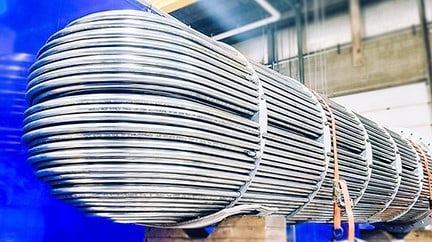Designing a shell and tube heat exchanger involves making several important decisions, with one of the most critical being the selection of the right material. The material choice directly impacts the exchanger’s performance, durability, and overall cost.
Material Selection for Heat Exchangers
Engineers have a wide range of materials to choose from when building a shell and tube heat exchanger. Steels and alloys come in different compositions, each offering unique properties that come with distinct advantages and disadvantages. Selecting the right material depends on how the exchanger will be used — factors such as the type of chemicals it will encounter, the operating temperature and pressure, and the environment it will be placed in all play significant roles. Additionally, the chosen material must be both cost-effective and readily available to manufacturers.
Why Duplex Stainless Steel is a Popular Choice
One material that stands out for many industries, including pharmaceuticals, oil and gas, and biotechnology, is duplex stainless steel. Known for its ability to handle high-stress applications, duplex stainless steel is composed of a combination of ferrite and austenite, offering both strength and corrosion resistance.
Stainless steel is categorized into different types based on its composition. Austenitic stainless steels are the most commonly used because of their versatility and ease of welding. However, they can crack under excessive heat or pressure.
Ferritic stainless steels, on the other hand, while not as durable as austenitic varieties, are highly resistant to corrosion and relatively easy to form. By combining both austenite and ferrite into duplex stainless steel, you get the best of both worlds: the strength of austenite and the corrosion resistance of ferrite.
Strength and Efficiency of Duplex Stainless Steel
Due to the strength of duplex stainless steel, engineers can design thinner-walled heat exchangers without sacrificing durability or corrosion resistance. Duplex stainless steel is typically twice as strong as austenitic stainless steel. Thinner walls reduce the amount of material needed, cutting manufacturing costs, while the lower weight can improve the exchanger’s efficiency.
Resistance to Corrosion and Chlorine
Corrosion resistance is another key factor in selecting materials for heat exchangers. Tubes that become corroded or pitted over time can eventually spring leaks, leading to problems such as:
- Fouling
- Cross-contamination
- Damage to tube sheets, shells, or other critical components
Not only are damaged tubes costly to replace, but they can also lead to equipment downtime, negatively impacting productivity.
Corrosion can occur when the material of the exchanger reacts with substances introduced during operation. For example, chlorine is a common cause of pitting corrosion, which can significantly weaken austenitic stainless steels in chlorine-heavy environments. Duplex stainless steel, however, offers superior resistance to the damaging effects of chlorine, making it ideal for industries that frequently work with this chemical.
High-Temperature Tolerance
Duplex stainless steels also tolerate high-temperature applications. While austenitic stainless steels begin to degrade at around 150°F when exposed to chloride and tensile stresses, duplex stainless steel can handle temperatures up to approximately 250°F without risk.
Tackling Rouging
Some industries, such as pharmaceuticals and biotechnology, must contend with rouging, a form of discoloration caused by oxygen exposure. This discoloration can lead to contamination if left unchecked. Cleaning rouging from equipment can be time-consuming and expensive, so selecting a rouging-resistant material is critical. While 316L austenitic stainless steel is popular in these industries for its resistance to rouging, duplex stainless steel has been found to offer even greater protection.
Cost Benefits of Duplex Stainless Steel
In addition to its performance advantages, duplex stainless steel also provides cost benefits. It contains lower levels of nickel and molybdenum compared to austenitic stainless steel, reducing its price and making it less vulnerable to price swings in the raw materials market.
Since duplex stainless steel is stronger, less material is needed to achieve the same durability as with austenitic or ferritic steels, further lowering costs. Over time, the reduced need for maintenance and replacement, thanks to the material’s strength and resistance to corrosion, can result in significant long-term savings.
Choosing the right materials for your shell and tube heat exchanger is critical to the performance and longevity of your system. For a durable, cost-effective, and corrosion-resistant solution, duplex stainless steel offers many advantages. At Enerquip, our team of expert engineers is ready to help you select the best materials and configuration to meet your unique operational needs. Contact us today to learn more about how we can help you increase the efficiency and longevity of your heat exchanger.

